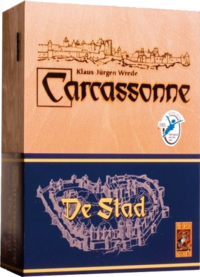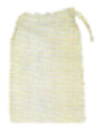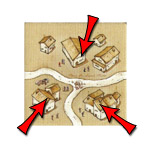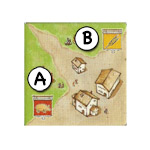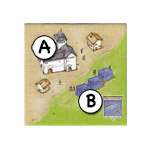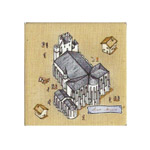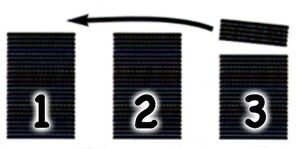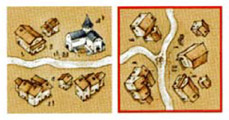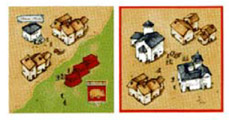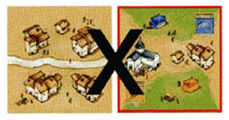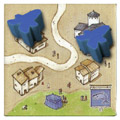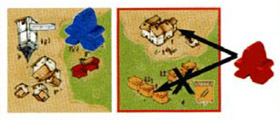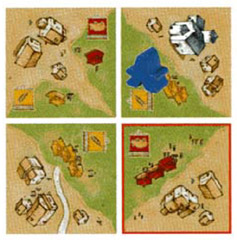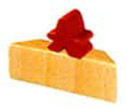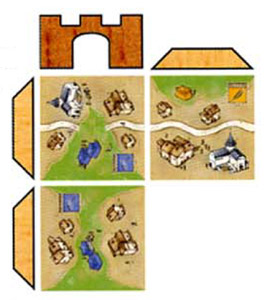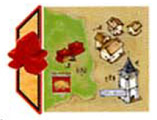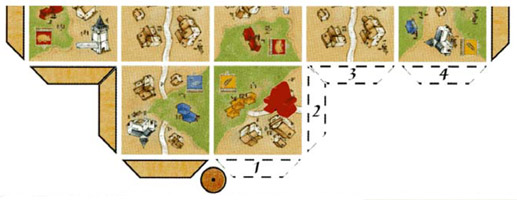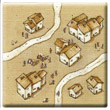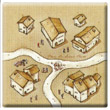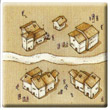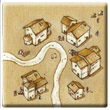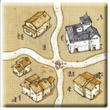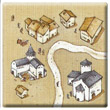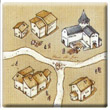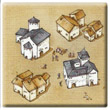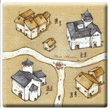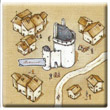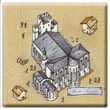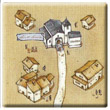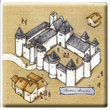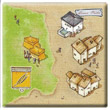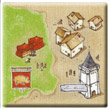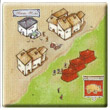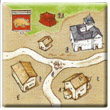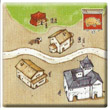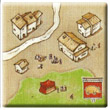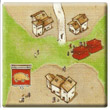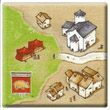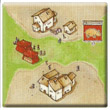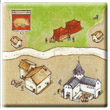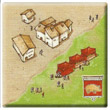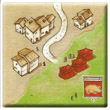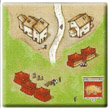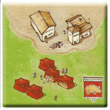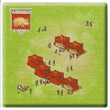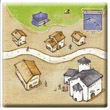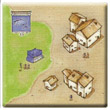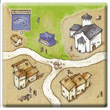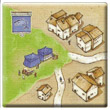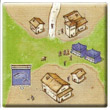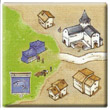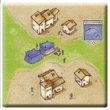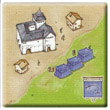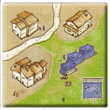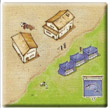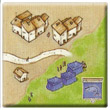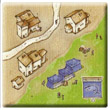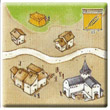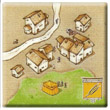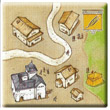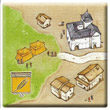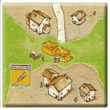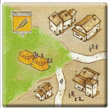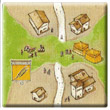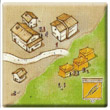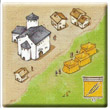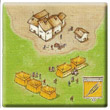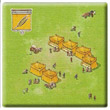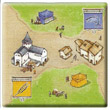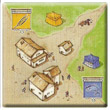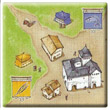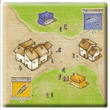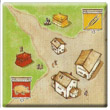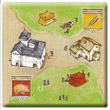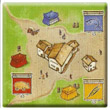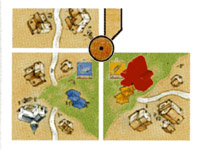De Stad Basisspel
Oorspronkelijk in Template:Year nl uitgegeven door Hans im Glück, is Carcassonne: De Stad een tegellegspel voor 2-4 spelers van 8 jaar en ouder. Het is gebaseerd op het spel Carcassonne van Klaus Jürgen Wrede, maar is niet met de andere spellen te combineren.
Het spel gebruikt veel van de standaard Carcassonne spelconcepten. De spelers maken de oude stad door tegels te leggen. Naarmate de stad groeit, worden de muren eromheen gebouwd, beginnend bij een enkele houten poort. De muur wordt opgebouwd uit houten stukken die aan het eind van het spel een 3D versie van de middeleeuwse stad vormen. Elke speler krijgt ook een aantal cilindrische houten torens (het aantal hangt af van het aantal spelers), waardoor de stadsmuren extra impact krijgen
"De indrukwekkende stad Carcassonne was al in de Middeleeuwen een trekpleister voor toeristen uit alle landen. Zijn grote markten, grandioze huizen en drukke straten maakten van de hele stad een populaire attractie. Hier is je kans om de stad Carcassonne te bouwen! Spelers bouwen muren en torens, stichten markten, en zetten op de gebruikelijke wijze horigen in. Aan het einde van het spel kunnen jullie allemaal genieten van de prachtige 3D-stad die jullie gebouwd hebben!"
Speelmateriaal
- 70 muurdelen
- 2 korte muren
- 1 stadspoort
- 12 torens
(l-r): standaard muurdeel, kort muurdeel, stadspoort, toren
- 32 horigen in 4 kleuren
- 2 buidels voor het bewaren van de stadstegels en houten speelstukken
- 1 scorebord
- 75 stadstegels met daarop diverse wegdelen, woonwijken, markten en gebouwen
| 3 stadsdelen, van elkaar gescheiden door de kruising |
3 woonwijken, van elkaar gescheiden door wegdelen |
veemarkt (A) graanmarkt (B) |
32 openbare gebouwen (A) vismarkt (B) |
7 historische gebouwen (genaamd): Petit Puits Grand Puits Tour Carrée Bâtiment Saint Sernin Saint Nazaire Chateau Comtal |
Het doel
De spelers werken samen om de stad Carcassonne te bouwen met woonwijken, markten (vis, graan en vee), wegen en muren.
Door hun horigen slim in te zetten, krijgen ze punten tijdens en aan het einde van het spel.
Voorbereiding
Elke speler krijgt 8 horigen in één kleur, zet er één van op veld 0 van het scorebord, en de rest als voorraad voor zich neer op tafel.
De spelers verdelen de 12 torens gelijkelijk
Schud de tegels gedekt en verdeel ze in drie stapels. De eerste stapel krijgt 30 tegels, de tweede 25 en de derde 20. De snelste manier om dit voor elkaar te krijgen is door eerst drie gelijke stapels te maken (met elk 25 tegels) en dan 5 tegels van de derde stapel te verplaatsen naar de eerste. Zet de eerste stapel zo neer dat alle spelers er gemakkelijk bij kunnen.
Leg de twee andere stapels met tegels, de 70 muurdelen, de 2 korte muurdelen en de stadspoort voorlopig opzij. Zij worden later in het spel gebruikt.
De spelers bepalen een startspeler. Die speler begint door de bovenste tegel van de eerste stapel te trekken en die midden op tafel te leggen. De speler mag één van zijn horigen op één van de projecten (weg, markt of woonwijk) van de tegel zetten. De spelregels voor het zetten van horigen worden verderop besproken.
Spelverloop
De spelers zijn, te beginnen met de startspeler, met de klok mee aan de beurt. Tijdens zijn beurt voert de speler die aan de beurt is de volgende acties in de aangegeven volgorde uit:-
- De speler moet een nieuwe tegel trekken en die aan de stad toevoegen
- De speler mag een horige uit zijn voorraad op de zojuist aangelegde tegel zetten
- Als door het aanleggen van de zojuist aangelegde tegel een weg of een markt is afgebouwd, wordt die nu geteld
Tegels aan de stad aanpassen
Als eerste actie moet de speler een stadstegel van de 1e stapel trekken en aanleggen[1], en wel als volgt:-
- De speler moet de nieuwe tegel (in alle voorbeelden aangegeven met een rode rand) met tenminste één zijde aan één of meer van de reeds gelegde tegels aanleggen. Dat mag niet zo dat alleen de hoeken elkaar raken.
- De speler moet de tegels zo aanleggen dat wegen (indien aanwezig) doorlopen [2]. Alle andere tegelprojecten mogen aan elkaar worden gelegd, ongeacht de projecten die erop staan.
| Wegdelen moeten doorlopen |
Een woonwijk mag aan een markt worden gelegd |
Dit is niet toegestaan omdat de weg op de eerdere tegel niet doorloopt op de aangelegde tegel |
Horige inzetten
Na het aanleggen van een tegel, mag de speler één van zijn horigen inzetten. Dat gaat als volgt:-
- De speler mag slechts 1 horige zetten
- De speler moet de horige uit zijn eigen voorraad nemen
- De speler mag de horige alleen op de zojuist aangelegde tegel zetten
- De speler moet de horige voorzichtig op één van de segmenten van de tegel zetten. Als...
| een burger | een marktvrouw | een beschermheer | ||
| of als | of als | |||
| op een wegdeel (staand) |
op een markt (staand) |
op een woonwijk (liggend op één van de aangegeven locaties) |
Beperkingen bij het inzetten
Als de aangelegde tegel een weg, markt of woonwijk van eerder gelegde tegels met een horige uitbreidt, mag de speler er geen horige meer op zetten (ook niet als de andere horige dezelfde kleur heeft). Het maakt niet uit hoe ver de andere horige weg staat, zolang het maar een voortzetting van het project is. Als een speler een tegel toevoegt waarmee een markt of weg afgebouwd wordt waar nog geen horige op staat, dan mag de speler daar geen horige zetten [3]. De drie voorbeelden hieronder zouden moeten helpen deze spelregels te verhelderen.
| Rood mag alleen een beschermheer zetten. Op de verbonden markt, staat al een marktvrouw van blauw |
Blauw mag een horige inzetten als marktvrouw , als burger of als beschermheer op de kleine woonwijk (rode pijl) daar er al een blauwe beschermheer op de grote woonwijk staat. |
Blauw mag geen horige op de onbezette markt zetten, omdat die door het aanleggen van de tegel zojuist werd afgebouwd. |
Heeft een speler geen horigen meer in voorraad, dan gaat hij verder met het aanleggen van tegels (maar kan geen horigen meer zetten). Dit gebrek aan horigen is meestal van korte duur aangezien spelers horigen terugkrijgen als er punten geteld worden.
Als door het aanleggen van een tegel een weg of een markt afgebouwd werd, wordt het afgebouwde project geteld. Woonwijken worden tijdens het spel niet geteld.
Nu is de beurt van de speler voorbij en is de volgende speler met de klok mee aan de beurt.
De puntentelling van wegen en markten
Een afgebouwde weg
Een weg is afgebouwd als de wegdelen aan elk uiteinde van de weg eindigen bij een kruising, een ander project of - later in het spel - tegen een muur. Een straat is ook afgebouwd als die een lus vormt. Tussen de uiteinden van de weg kan een willekeurig aantal wegdelen zitten. Het aantal punten wat je krijgt is afhankelijk van het aantal tegels waaruit de weg bestaat.
Voor een afgebouwde weg met 1-3 tegels krijgt de speler met een burger op die weg 1 punt voor elke tegel waarop de weg is afgebeeld (aantal tegels in de weg, niet aantal wegdelen).
Voor een afgebouwde weg met 4 of meer tegels krijgt de speler met een burger op de weg het dubbele aantal punten (aantal tegels x 2).
De spelers verwerken de punten die ze gekregen hebben onmiddellijk op het scorebord door hun horige zoveel velden vooruit te zetten als men gekregen heeft. Als de scorepion de 0 passeert (50 punten), dient de horige plat gelegd te worden om aan te geven dat er meer dan 50 punten zijn behaald.
Een afgebouwde markt
Een markt is afgebouwd als deze niet meer uitgebreid kan worden (aan alle kanten begrensd) en er geen gaten meer in zitten. Een markt kan uit een willekeurig aantal tegels bestaan.
Voor een afgebouwde markt krijgt de speler die een marktvrouw op die markt heeft punten gelijk aan het aantal tegels waaruit de markt bestaat, vermenigvuldigd met het aantal verschillende soorten markten (vis, graan en vee). Alleen de eerste van de verschillende soorten markt telt mee voor de vermenigvuldigingsfactor. Meerdere exemplaren van hetzelfde type markt voegen niets toe.
Wat gebeurt er als er meerdere horigen op een afgebouwde weg of markt staan?
Through clever tile and follower placement, it is possible for a completed street or market to have several followers. This happens when separate features are connected. In this case, the player with the most followers on the feature scores all the points. When players tie with the most followers on a feature, each scores the full points. Players not tied for the most, score nothing.
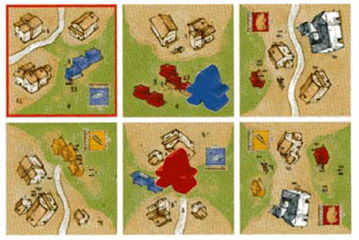
Red and blue both score full points, in this case 18 points (3 kinds x 6 tiles), as each ties with the most sellers (1) on the market.
Editor's Note: The tile in the top right corner of this example has been incorrectly placed - the road should not end against a residential area, and is a known error in the 2004 HiG and RGG rules.
Returning followers to their owners
After a street or market is complete and scored - and only then - the follower (citizen or seller) on the scored feature is returned to its owner's supply. As the player has already passed the part of their turn for placing a follower, the player may first place a returned follower in any role that is allowed on their next turn.
The residential areas
Residential areas are scored at game end and not when they are completed. Thus, the followers placed on them must stay until the end of the game. Residential areas are bordered by streets, markets and walls (this is important for the game-end scoring of them).
Players earn points for their stewards only at game end. Stewards remain on the residential areas, once placed. They are not returned to their owners until game end! To reinforce this visually, players place them lying down instead of standing on the tiles!
The walls enter the game
After the player's turn when the last tile of the first stack was drawn, the player brings forth the second stack of tiles, which players will now draw tiles from. The walls and towers now come into play as well. Players may now place followers on the walls, as guards.
Walls, towers and the city gate
From now on, when a player places a tile that completes a street or market, causing the feature(s) to be scored, the game is interrupted after all scoring (more than one feature may be completed by a single tile placement) for wall building.
With the very first scoring after players start drawing tiles from the second stack, the player who played the tile that caused the scoring takes the city gate piece. Each other player takes one wall piece. The player with the city gate places it next to any tile (on the city) of their choice [4] [5]. In clockwise order, the other players place their walls adjacent to the gate (or to other walls) to the right or left of the city gate. In this way, they build the city walls around the city. The wall acts as a barrier to future tile additions - tiles cannot be placed beyond the walls (or city gate) [6].
With each further scoring, each player takes 1 wall. Beginning with the player who placed the tile causing the scoring, each adds their wall piece to the previously started city wall, placing their wall piece adjacent to a previous wall or the city gate.
Whenever a player adds a wall to the city wall, the player may immediately place a follower from their supply on the wall piece just placed, as a guard [7]. Restriction : If there is already a guard on the wall directly opposite the wall just placed, the player may not place a guard on the wall.
Guards are scored at the end of the game, and remain on the walls, once placed, until then.
After all the players have placed their walls, the player whose tile placement caused the scoring may place one of their towers at either end of the city wall. The player scores 1 point for each wall piece between the tower just placed, and a previous tower (or city gate) along the city wall.
Building walls may cause markets or streets to complete
When a wall causes a street or market to be complete, the completed street or market is immediately scored [8] [9]
Scoring caused by wall building does not trigger a new round of wall building.
After the player's turn when the last tile is drawn from the second stack, the player brings forth the third stack of tiles, which the players will now draw tiles from. Play then continues as before with one small change - after each scoring, each player will build two walls. As before, the player whose tile placement caused the scoring, places the first wall, with the others following in clockwise order twice around the table until all have placed 2 walls. Also, as before, after a player places a wall, they may immediately place one follower from their supply on the wall using the rules described above. After the walls are built, the player whose tile placement caused the scoring may place a tower as described above.
If there are not enough walls in the supply for all players to build 2 walls, each builds as many as possible, starting with the player whose tile placement caused the scoring, and continuing clockwise around the table, up to twice, until the walls are exhausted.
Game End
The game ends in one of the following ways :-
In every case, the city wall is completed, enclosing the city. If there are enough walls, simply place them around the last unwalled tiles [12]. If there are not enough walls, just assume they are there and that they completely enclose the city. Streets and markets completed by the placement of these last walls are now scored. In the previous example, red scores 1 point for the completed street.
Now, remove all followers from incomplete streets and markets. For these, players will score no points. Incomplete street and markets at game-end are caused by empty spaces within the city.
Then the players perform final scoring.
Final Scoring
In the final scoring, players score their stewards and guards.
The stewards score points for markets
Residential areas are scored whether complete or not. If only one player has a steward in a residential area, that player is the owner of the residential area. If several players have stewards in the same residential area, the player with most stewards is the owner. If players tie for most stewards in a residential area, those tied with most are the owners of the residential area. The owner(s) of a residential area score 2 points for each market that is adjacent to the residential area. It matters not whether the market is complete or not, nor how large the market is.
The guards on the walls score points
Each guard watches over the row (or column) of city tiles that lie before him.
For each public building on the tiles in the row (or column), the owner of the guard scores 2 points.
For each historic building on the tile in the row (or column), the guards scores 3 points.
| Red scores 9 points for 3 public and 1 historic building. | |
| Red scores 5 points (1 public, 1 historic). Blue scores 4 points (2 public). Each scores points only on their side of the row - up to the empty space. | |
| When an empty space is filled after the guards are placed, each scores 9 points [13]. |
The player with the most points wins.
Special rules for 2 players
With 2 players the number of walls built is doubled.
- After scoring during the 2nd stack each player builds 2 walls
- After scoring when using the third stack, each player builds 4 walls
The players take turns building 1 wall each until they have built 2 or 4 walls.
In the very first wall building round with the 2nd stack, the player whose tile placement caused the scoring builds the city gate first, then the other player builds 1 wall, then the tile placing player builds 1 wall and, finally, the other player builds 1 wall.
Tile Distribution
Voetnoten
Kijk op de Pictogrammen pagina voor uitleg over en licensering van de pictogrammen.
- ↑
 RGG bevestigt dat als de tegel niet kan worden aangelegd die, evenals bij andere Carcassonne-spellen, opzijgelegd en er een vervangende tegel wordt getrokken.
RGG bevestigt dat als de tegel niet kan worden aangelegd die, evenals bij andere Carcassonne-spellen, opzijgelegd en er een vervangende tegel wordt getrokken.
- ↑
 Dat betekent niet dat je een weg moet verlengen als er een weg op de tegel die je getrokken hebt staat, alleen dat als je de tegel aan wilt leggen aan een tegel waar een weg op staat, de weg door moet lopen.
Dat betekent niet dat je een weg moet verlengen als er een weg op de tegel die je getrokken hebt staat, alleen dat als je de tegel aan wilt leggen aan een tegel waar een weg op staat, de weg door moet lopen.
- ↑
 Merk op dat dit afwijkt van de meeste Carcassonne-spellen.
Merk op dat dit afwijkt van de meeste Carcassonne-spellen.
- ↑
 The City Gate may be placed against any type of tile edge - it does not have to be "across" a street - as show in the example.
The City Gate may be placed against any type of tile edge - it does not have to be "across" a street - as show in the example.
- ↑
 The City Gate may not be placed against a tile in a hole within the city.
The City Gate may not be placed against a tile in a hole within the city.
- ↑
 Thus, it is illegal to place a tile such that it causes the city wall to be surrounded.
Thus, it is illegal to place a tile such that it causes the city wall to be surrounded.
- ↑
 No guard may be placed on the actual City Gate, but other players in the first round of wall placement can place guards. RGG originally indicated (2007) that no guards could be placed by any player during the first wall building round, but this was changed by HiG (2015). The first player (placing the City Gate) gets to choose the starting position, that's all.
No guard may be placed on the actual City Gate, but other players in the first round of wall placement can place guards. RGG originally indicated (2007) that no guards could be placed by any player during the first wall building round, but this was changed by HiG (2015). The first player (placing the City Gate) gets to choose the starting position, that's all.
- ↑
 If a player has no followers available in their supply, can they use a follower returned from a street or market, closed by the wall placement, as a guard on that piece of wall? Both views are argued on BGG.
If a player has no followers available in their supply, can they use a follower returned from a street or market, closed by the wall placement, as a guard on that piece of wall? Both views are argued on BGG.
- ↑
 In this situation, where a wall is placed such that the market, occupied by red cannot be extended, the market cannot be scored and red remove their follower until the next segment of wall has been built. This would also apply for a street.
In this situation, where a wall is placed such that the market, occupied by red cannot be extended, the market cannot be scored and red remove their follower until the next segment of wall has been built. This would also apply for a street.
- ↑
 The HiG version of the rules translates as "... the two ends of the wall are so close to each other that only 5 or less walls can be built".
The HiG version of the rules translates as "... the two ends of the wall are so close to each other that only 5 or less walls can be built".
- ↑
 The game also ends, if during wall placement, the city is completely surrounded. RGG has ruled that a final tower can be placed at the point where the two halves of the wall met. However, the player only scores wall segments in one direction up to the next tower.
The game also ends, if during wall placement, the city is completely surrounded. RGG has ruled that a final tower can be placed at the point where the two halves of the wall met. However, the player only scores wall segments in one direction up to the next tower.
- ↑
 No guards may be placed on these wall sections, although RGG has, at one time, ruled that you can still do placements on the final wall-building round. It is just a means to finish the walls of the city for a completed look.
No guards may be placed on these wall sections, although RGG has, at one time, ruled that you can still do placements on the final wall-building round. It is just a means to finish the walls of the city for a completed look.
- ↑
 If both Guards are of the same colour, do they still both score? Yes, each guard is scored independently.
If both Guards are of the same colour, do they still both score? Yes, each guard is scored independently.
